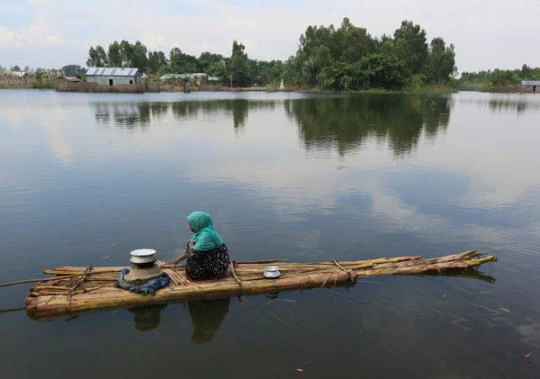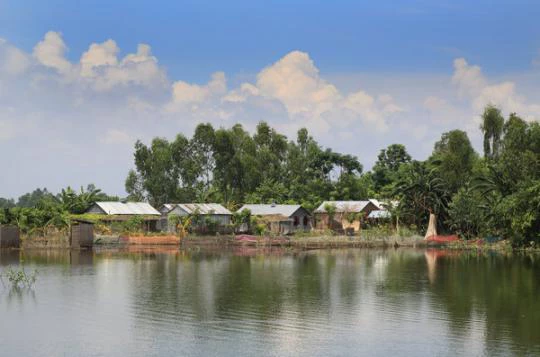A smiling Mosammet Sukkur Jahan, walks to her thatched home in Datiar Char (shoal) in northern Bangladesh to prepare lunch for her family. While eating, Jahan and her neighbors Sharifa, Amena, and Halima were at ease as flood water rushed around their homes located in the middle of vast Teesta River during August and September 2014. They live on a shoal, which is an elevated sandbar that keeps their homes dry.
Chars or Shoals form through siltation along riverbeds. The constant interplay of erosion and accretion creates and sustains the shoals. There are mainly three types of chars: dead, mature, and running. Dead chars are usually permanent land formations. Mature chars are the ones that have not faced any major changes for 10-15 years. Running chars face regular changes and continuous emerge and disappear. The emergence and erosion determines the intensity of vulnerability in the ‘chars’. Typically a new char land requires at least 10 years of continuous presence before it becomes habitable for people.
Irrespective of types, people on the chars usually face flooding two to three times every year. Most residents live around the poverty line and suffer from hunger. They fetch drinking water from hand tube wells and often use unsealed pit latrines. Agriculture has certain cropping pattern because of wide-ranging sandbars, facilitating groundnut and fodder cultivation. Paddy cultivation is prevalent in some chars, particularly in those existing for a longer time. Transport is mainly via bicycle and foot. Electricity is scarce and kerosene lamps provide light. Cooking fuel is mainly wood.
The Bangladesh Climate Change Resilience Fund (BCCRF) is supporting Bangladesh to increase resilience to climate change. BCCRF recognizes the importance of local empowerment and nongovernmental organizations (NGOs) in community-based programs and services, often in partnership with government and international development partners. BCCRF is funding the Community Climate Change Project (CCCP) with participation of NGOs. The CCCP aims to strengthen resilience of local community to cope with current and future climate stresses by improving infrastructure, adapting agricultural practices, and finding innovative income sources.

Plinth-raising is one example of helping local community to be more resilient to floods. The raised homes amid vast stretches of flat, sandy land protects group of families and their homes from inundation during the inland monsoon flooding so that the communities do not need to migrate. To save the flood affected families, many homes were built in clusters in May 2014.
In August 2014, floods hit northern Bangladesh in the greater Rangpur regions. Flood waters inundated nearly all the chars, including Dhushmara, Datiar, Bazra, Kudalkati and Manushmara. Helped by the plinths, Jahan said, “Almost every year in the last 27 years, we had to move to higher grounds during the floods. This is the first time we stayed at home.” Jahan’s husband, Hashem Ali added, “The difference is our homes are on higher and safer ground.”
Every year, hundreds of domestic animals are lost in the flood incurring huge losses for the families who make a living from selling milk and eggs. Mossammet Shelina, who also built homes on plinth said, “The plinths rescued us, our cattle and poultry. Flood waters could not even reach the courtyard of the raised ground.”
With their land now protected, the communities started growing vegetables and seedlings on the plinths. Showing her mini vegetable garden, 27 year old Munni in the Dhushmara char said, “All six of us families living together on this plinth have similar vegetable gardens.” Many farmers, who lost crops in sudden floods, grew paddy seedlings on the plinths for planting on the highly fertile land.
The $12.5 million World Bank administered project also has a comprehensive approach for beneficiary sustainability. CCCP, through NGOs, supports a variety of activities to help char residents: installing tube wells for reducing bacterial contamination risk in drinking water; providing flood-tolerant seeds; introducing latrines and providing vaccines for domestic animals, cementing pillar for the houses, and introducing improved cooking stoves.
Jahan, Sharifa, Amena Begum, Halima Akter’s smiling faces speak for themselves and their strength in building resilience rather than falling victim to the worst effects of changing climate.




Join the Conversation